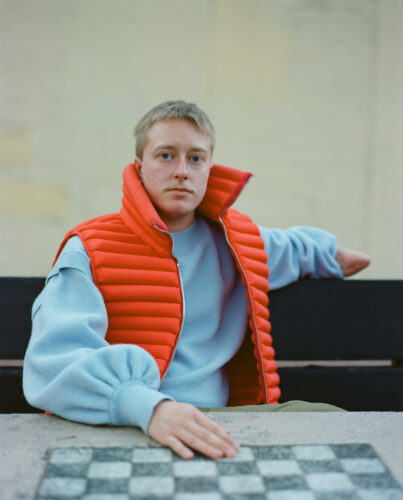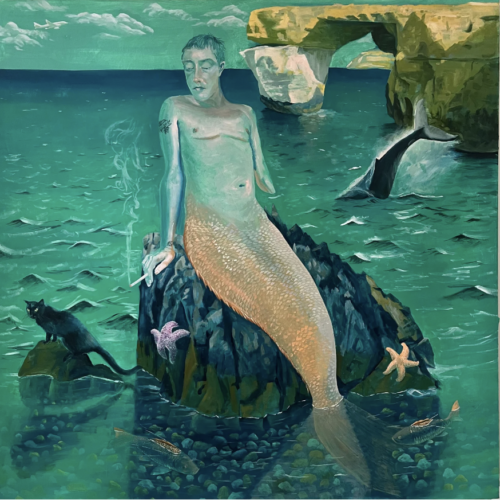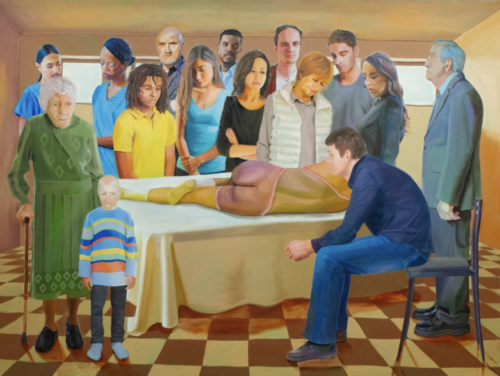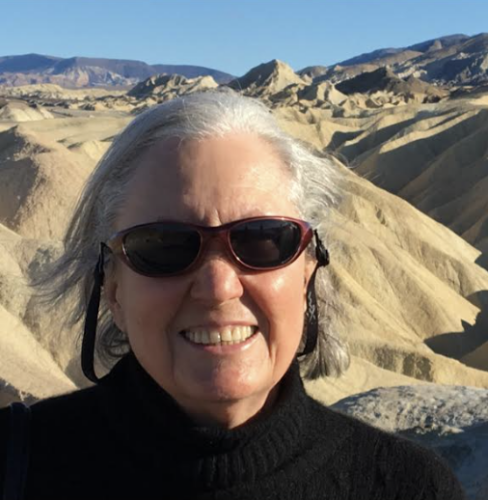
Linus Borgo: Monstrum
Yossi Milo Gallery
Nov. 30, 2023-Feb. 2, 2024
Visceral and shocking to many, Linus Borgo’s first solo show, Monstrum, at Yossi Milo Gallery on Tenth Avenue in the trendy, Chelsea art district of NYC, seeks to awaken and educate viewers on what one is willing to sacrifice to feel at home in their body. Borgo is a young figurative painter who references traditional Italian Renaissance techniques, myths, and fairy tales to offer insights into his transition from a disabled female to male person.
Born in 1995 in Stamford, Connecticut, Borgo’s decision to transition was decades in the making, complicated by a traumatic electrical accident resulting in the amputation of his left forearm and hand. In 2013, he started taking testosterone as part of hormonal therapy and came out as transgender.

A large oil painting entitled “The End Of The World As We Know It” is the first piece that greets viewers in a small entry gallery. This painting takes inspiration from the myth of Phaethon, the son of Helios, the Sun God. As the myth goes, Phaethon wants to drive his father’s sun chariot for a single day. Being young and foolish, he first flies too high, freezing the earth. Attempting to correct his error, he descends too low, burning it. Zeus, the god of thunder, kills Phaethon with a lightning bolt, stopping the chariot and preventing him from destroying the earth.
Borgo’s painting conflates this myth with his electrical accident. In it, we see the sun chariot’s horses running free over lower Manhattan away from a fiery setting sun. In the background on the left is a powerplant that was the site of Linus’s tragic accident, and the Parthenon stands in ruins on the right. The Freedom Tower’s (Sept. 11, 2001 memorial) syringe-like panicle pierces the sun.

Moving to the left is “Le Cygne,” painted in 2023. This smaller canvas, 48” x 34”, references Leda, a Spartan queen, and the swan, where Zeus disguises himself as a white swan to seduce and rape Leda. Seated in a magical forest, we see Linus embracing the swan and wearing a ballet toe shoe, referencing his training as a ballerina. This is a trope of transformation that characterizes many Greek myths and fairy tales.
Turning to the left wall, we revisit Linus’s hospitalization through a Frankenstein-like assembly of parts as a way to experience his feelings of being “just a body on a bed.” A group of random people (no connection to the artist) that can be seen as a kind of audience of witnesses is observing the operation in an old-fashioned surgical theater. The space is a limbo-like room outside of real time. The bed is a floating shape with no legs, hence the title “Bedsheet Ghost.”
Walking down the corridor across from the reception desk brings you into the more extensive main gallery. Many paintings here pay homage to the surgical procedures, stitches, and bodily rearrangements that Borgo asserts are visions and flashbacks between humans, metaphysical dreams, and nightmares.
“I Feel Fine” (2017) portrays the artist sitting on a natural rock formation that collapsed into the surrounding water. One sees the ghost of the artist’s dead cat, Elsina, on another rock. On the right side of the painting, there is a whale, a species that is facing extinction, dangerously close to the shore. The starfish, a recurring symbol in Borgos’ art, appears as a regenerative being that can regrow cut-off limbs. This painting invites us to think about universal themes that go beyond the physical to underlying emotions: the grief Borgo feels for his companion animal friend, his absent hand and forearm, the disappearing earth, and the possible extinction of the great whales.

In Monstrum, Borgo gives birth to, and affirms, his gender transition. In Latin, Monstrum is a thing that evokes fear and wonder (metonymically), a monster, a monstrosity, whether in size or character—a divine omen indicating misfortune, an evil omen, portent, and a neuter.
Consequently, Borgo challenges spectators and critics to open their eyes and hearts and stop marginalizing people with disabilities and gender differences as freaks and outsiders. Monstrum is about traveling on a different road to wholeness. Each painting depicts the sacrifices Borgo and the transgender community have made, and continue to make, to be seen as the people they know themselves to be, in bodies that they view as authentic.
Borgo made sacrifices to find new friends, new horizons, and a life infused with what Jungian analyst Lisa Marchiano talks about in her latest book, The Vital Spark: Reclaim Your Outlaw Energies and Find Your Feminine Fire. Holding up a feminist manifesto to partially explain a transformation from female to male may seem contradictory, but it is about the creative impulse to transform one’s existence. I do not know if Borgo is familiar with Carl Jung’s work on the self, but he has left parts of his former female body behind to give birth to himself and what feels is normal for him. Along the way, he kept his love for making art and found his burning truth despite the limitations of the body he was born into, thus becoming the embodiment of his genuine masculinity.
This is a time when transgender rights are in the crosshairs, with about one hundred and thirty bills specifically targeting transgender issues. Yossi Milo is a gallery known for its courage in taking on hot-button issues and providing a secure space for viewers to experience diverse art and ideas. Borgo’s paintings and sculptures invite us to rethink our notions of gender and masculinity. This is not new, and as Kate Bernstein, in the catalog for the 1996 Gender Fucked, asserted, “Sex is fucking, gender is everything else.” At a time when being authentically seen is central to the current politicized culture wars, Borgo and his art live between the worlds, a space of liberation where a new order of being begins.
I leave you to ponder a final question regarding Borgo’s art, raised by The National Center on Transgender Equality’s current survey of over 92,000 binary and nonbinary respondents; the majority are satisfied with their lives. What right do individuals who do not question their biological bodies have to dictate to others who do?
Borgo’s work will also be featured at the upcoming Dallas Art Fair, available to view from April 4-7, 2024.

Cassandra Langer graduated from NYU with a doctorate in critical studies and art history, is a Smithsonian postdoctoral fellow, and is the author of 10 books; she has also written for Arts magazine, College Art Journal, Art Papers, Woman’s Art Journal, Ms. Magazine, Women’s Review of Books, New York Newsday, Sinister Wisdom and The Gay and Lesbian Review Worldwide. She is currently working on My Gay Miami 1960-1979.






